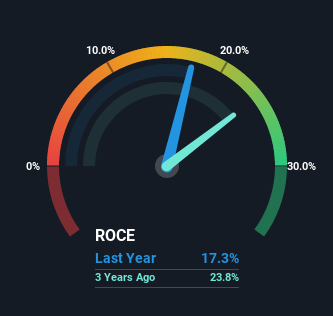Lancaster Colony's (NASDAQ:LANC) Returns On Capital Not Reflecting Well On The Business
Finding a business that has the potential to grow substantially is not easy, but it is possible if we look at a few key financial metrics. Typically, we'll want to notice a trend of growing return on capital employed (ROCE) and alongside that, an expanding base of capital employed. This shows us that it's a compounding machine, able to continually reinvest its earnings back into the business and generate higher returns. Although, when we looked at Lancaster Colony (NASDAQ:LANC), it didn't seem to tick all of these boxes.
Understanding Return On Capital Employed (ROCE)
Just to clarify if you're unsure, ROCE is a metric for evaluating how much pre-tax income (in percentage terms) a company earns on the capital invested in its business. To calculate this metric for Lancaster Colony, this is the formula:
Return on Capital Employed = Earnings Before Interest and Tax (EBIT) ÷ (Total Assets - Current Liabilities)
0.17 = US$164m ÷ (US$1.1b - US$173m) (Based on the trailing twelve months to December 2021).
Therefore, Lancaster Colony has an ROCE of 17%. On its own, that's a standard return, however it's much better than the 9.3% generated by the Food industry.
View our latest analysis for Lancaster Colony
In the above chart we have measured Lancaster Colony's prior ROCE against its prior performance, but the future is arguably more important. If you'd like, you can check out the forecasts from the analysts covering Lancaster Colony here for free.
So How Is Lancaster Colony's ROCE Trending?
When we looked at the ROCE trend at Lancaster Colony, we didn't gain much confidence. To be more specific, ROCE has fallen from 32% over the last five years. Although, given both revenue and the amount of assets employed in the business have increased, it could suggest the company is investing in growth, and the extra capital has led to a short-term reduction in ROCE. And if the increased capital generates additional returns, the business, and thus shareholders, will benefit in the long run.
In Conclusion...
Even though returns on capital have fallen in the short term, we find it promising that revenue and capital employed have both increased for Lancaster Colony. In light of this, the stock has only gained 36% over the last five years. So this stock may still be an appealing investment opportunity, if other fundamentals prove to be sound.
If you want to continue researching Lancaster Colony, you might be interested to know about the 1 warning sign that our analysis has discovered.
While Lancaster Colony may not currently earn the highest returns, we've compiled a list of companies that currently earn more than 25% return on equity. Check out this free list here.
Have feedback on this article? Concerned about the content? Get in touch with us directly. Alternatively, email editorial-team (at) simplywallst.com.
This article by Simply Wall St is general in nature. We provide commentary based on historical data and analyst forecasts only using an unbiased methodology and our articles are not intended to be financial advice. It does not constitute a recommendation to buy or sell any stock, and does not take account of your objectives, or your financial situation. We aim to bring you long-term focused analysis driven by fundamental data. Note that our analysis may not factor in the latest price-sensitive company announcements or qualitative material. Simply Wall St has no position in any stocks mentioned.

